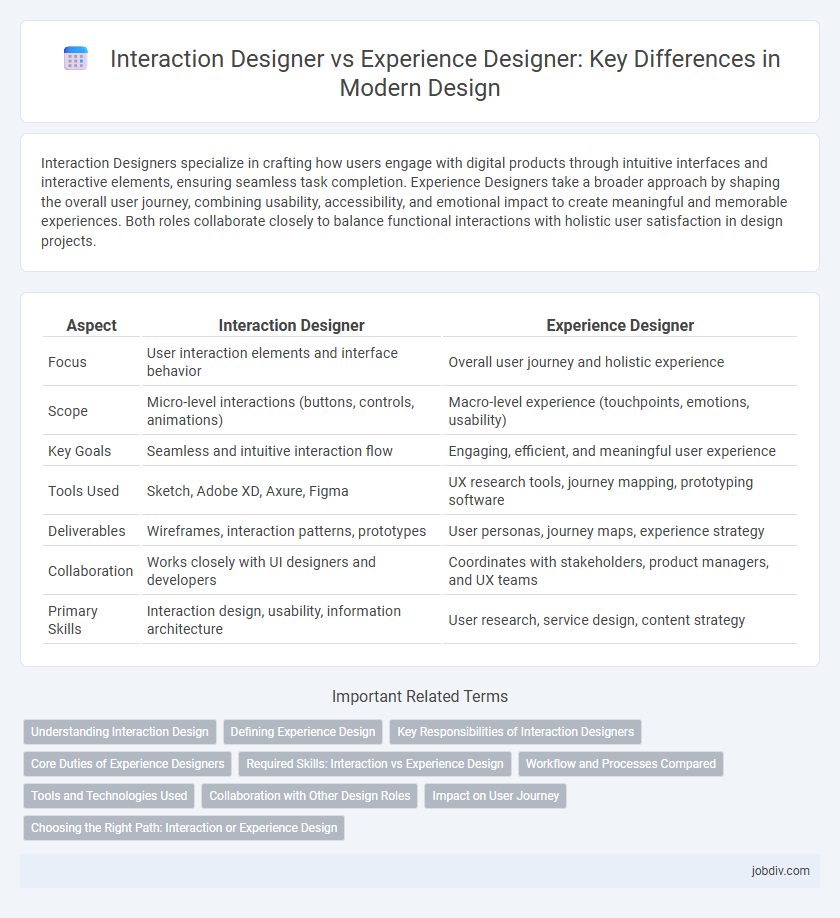Interaction Designers specialize in crafting how users engage with digital products through intuitive interfaces and interactive elements, ensuring seamless task completion. Experience Designers take a broader approach by shaping the overall user journey, combining usability, accessibility, and emotional impact to create meaningful and memorable experiences. Both roles collaborate closely to balance functional interactions with holistic user satisfaction in design projects.
Table of Comparison
| Aspect | Interaction Designer | Experience Designer |
|---|---|---|
| Focus | User interaction elements and interface behavior | Overall user journey and holistic experience |
| Scope | Micro-level interactions (buttons, controls, animations) | Macro-level experience (touchpoints, emotions, usability) |
| Key Goals | Seamless and intuitive interaction flow | Engaging, efficient, and meaningful user experience |
| Tools Used | Sketch, Adobe XD, Axure, Figma | UX research tools, journey mapping, prototyping software |
| Deliverables | Wireframes, interaction patterns, prototypes | User personas, journey maps, experience strategy |
| Collaboration | Works closely with UI designers and developers | Coordinates with stakeholders, product managers, and UX teams |
| Primary Skills | Interaction design, usability, information architecture | User research, service design, content strategy |
Understanding Interaction Design
Interaction design centers on creating intuitive interfaces that facilitate seamless user interactions with digital products through effective layout, controls, and feedback mechanisms. It emphasizes the micro-level elements such as button behavior, navigation flow, and interactive animations to enhance usability and engagement. Understanding interaction design requires deep knowledge of human-computer interaction principles, cognitive psychology, and prototyping tools to craft meaningful and efficient user experiences.
Defining Experience Design
Experience Design centers on crafting holistic user journeys that integrate emotions, behaviors, and context to create meaningful interactions across multiple touchpoints. It encompasses the strategic alignment of user needs, business goals, and technology to deliver cohesive and engaging experiences. Interaction Designers focus more narrowly on the specific elements of user interface behavior and usability within these broader experiences.
Key Responsibilities of Interaction Designers
Interaction Designers focus on creating intuitive interfaces by defining user flows, wireframes, and interactive elements that facilitate seamless user engagement. They collaborate with developers to implement responsive designs ensuring usability across devices. Their key responsibilities include prototyping, usability testing, and refining interactions based on user feedback to enhance overall product functionality.
Core Duties of Experience Designers
Experience Designers focus on crafting seamless and meaningful user journeys by integrating research insights, user behavior analysis, and emotional impact assessments into their design process. Their core duties include mapping customer touchpoints, creating prototypes that enhance usability, and collaborating cross-functionally to ensure consistent brand experiences across digital and physical platforms. This holistic approach prioritizes user satisfaction and long-term engagement rather than isolated interface elements.
Required Skills: Interaction vs Experience Design
Interaction Designers require proficiency in wireframing, prototyping, and usability testing to craft seamless user interfaces and ensure intuitive navigation. Experience Designers emphasize skills in user research, journey mapping, and emotional design to create holistic and meaningful user experiences across multiple touchpoints. Both roles demand strong collaboration, empathy, and a deep understanding of user-centered design principles.
Workflow and Processes Compared
Interaction Designers focus on creating intuitive interfaces by designing specific touchpoints and defining user interactions within a system. Experience Designers approach the workflow by mapping entire user journeys, ensuring seamless transitions and cohesive emotional engagement throughout all stages. While Interaction Designers emphasize micro-interactions and immediate usability, Experience Designers prioritize holistic process integration and long-term satisfaction.
Tools and Technologies Used
Interaction Designers primarily use tools like Sketch, Figma, and Axure to create wireframes and interactive prototypes that focus on user interface elements and microinteractions. Experience Designers leverage a broader set of technologies including UX research platforms like UserTesting, analytics tools such as Google Analytics, and design systems integrated with tools like Adobe XD to craft holistic user journeys. Both roles increasingly incorporate collaboration software like Miro and Jira to streamline workflows and stakeholder communication.
Collaboration with Other Design Roles
Interaction Designers collaborate closely with Visual Designers and UX Researchers to ensure seamless user interfaces that align with user needs and aesthetics. Experience Designers work alongside Product Managers, Content Strategists, and Interaction Designers to craft holistic user journeys that integrate functionality, content, and emotional impact. Both roles rely on agile teamwork and iterative feedback loops to refine design solutions and achieve cohesive user experiences.
Impact on User Journey
Interaction Designers focus on crafting intuitive interfaces that streamline specific touchpoints within the user journey, emphasizing task completion and responsiveness. Experience Designers take a holistic approach, shaping the entire user journey by integrating emotional, functional, and sensory elements to create a cohesive brand experience. The impact of Interaction Designers centers on user engagement at discrete moments, while Experience Designers influence long-term satisfaction and loyalty across all interactions.
Choosing the Right Path: Interaction or Experience Design
Interaction Designers concentrate on crafting intuitive user interfaces that facilitate seamless interactions through precise control over elements like buttons, gestures, and feedback. Experience Designers adopt a broader approach, shaping the entire customer journey by integrating usability, accessibility, and emotional impact across multiple touchpoints. Selecting between Interaction and Experience Design depends on whether one prefers focusing on detailed interface mechanics or orchestrating holistic user journeys.
Interaction Designer vs Experience Designer Infographic

 jobdiv.com
jobdiv.com